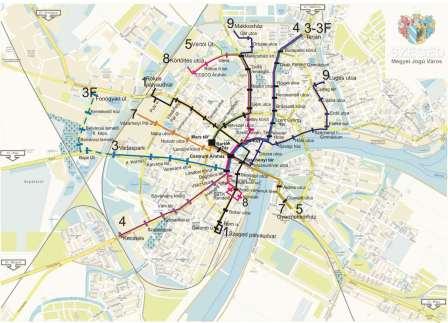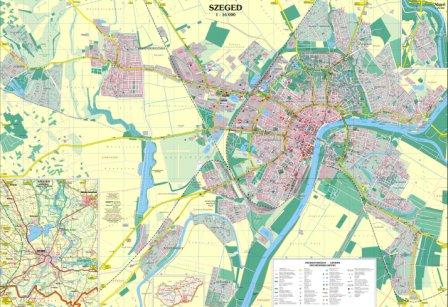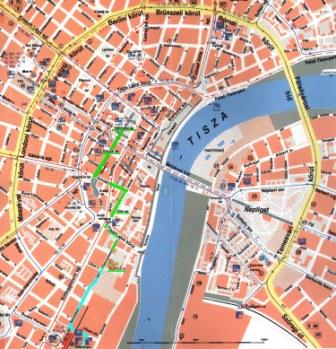Attractions
in Szeged
Museums in Szeged
There are several museums in Szeged, I only chose the most known places. There are smaller galleries as well and temporary exhibitions too. Cultural life is very vivid in Szeged so there must be some interesting exhibitions going on while you are visiting Szeged. The local tourist office in Szeged will keep you informed.
Pick Museum
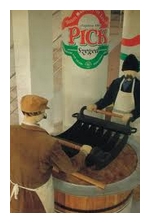 When
you visit Szeged it is a must to visit the Pick museum. You will be
shown
how the world famous Pick salami or Szeged wintersalami is made. You
can find out what ingredients are used and what technology is needed in
order to produce this fine product. You can also learn about the
history of the factory, how it became one of the largest food
processing company and how Pick salami became world famous. Apart from
Pick salami Szeged paprika plays an important part of the exhibition
since it is a vital part of the salami making. You can find out
everything about
paprika here.
When
you visit Szeged it is a must to visit the Pick museum. You will be
shown
how the world famous Pick salami or Szeged wintersalami is made. You
can find out what ingredients are used and what technology is needed in
order to produce this fine product. You can also learn about the
history of the factory, how it became one of the largest food
processing company and how Pick salami became world famous. Apart from
Pick salami Szeged paprika plays an important part of the exhibition
since it is a vital part of the salami making. You can find out
everything about
paprika here.
Int he gift shop you can buy both salami
and paprika products at discount prices! The museum is open every day
between 3 pm- and 6 pm. but groups can visit the place at other times
between 10 am. and 6 pm. with previous registration.
Address: Szeged, Felso-Tisza part 10
Mora Ferenc Museum
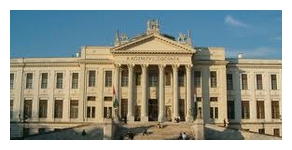 Mora
Ferenc museum is the largest museum in Szeged. It used to work together
with the city library but since 1950 it has been an independent
institution. You can find out a lot about Szeged in the etnography
exhibition where you can see more than 20,000 pieces of work related to
the life of people of the region. You can also visit the archeological
exhibition to find out more about the history of the area in the
previous ages. There are other exhibitions where you can see paintings
from famous Hungarian painters, coins or objects related to nature. It
is worth going to Mora Ferenc museum as it has an enormous collection
of pieces in connection with the past and present of Szeged.
Mora
Ferenc museum is the largest museum in Szeged. It used to work together
with the city library but since 1950 it has been an independent
institution. You can find out a lot about Szeged in the etnography
exhibition where you can see more than 20,000 pieces of work related to
the life of people of the region. You can also visit the archeological
exhibition to find out more about the history of the area in the
previous ages. There are other exhibitions where you can see paintings
from famous Hungarian painters, coins or objects related to nature. It
is worth going to Mora Ferenc museum as it has an enormous collection
of pieces in connection with the past and present of Szeged.
Address: Szeged, Roosevelt ter 1-3
Black House / Fekete Haz
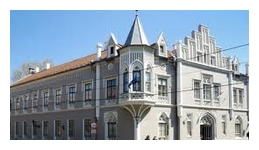 This
house is part of Mora Ferenc museum. The origin of the collection dates
back to the end of the First World War. Those who came back from the
war brought a lot of things which reminded them of their city, Szeged
or
became the symbol of defending their country during the war. These
relics were given to Szeged in the autumn of 1918 and these object were
the base of the collection. During the years many more were added to
the collection and today there is a large exhibition in the house in
Somogyi street, which has been the place for the exhibition since 1980.
This
house is part of Mora Ferenc museum. The origin of the collection dates
back to the end of the First World War. Those who came back from the
war brought a lot of things which reminded them of their city, Szeged
or
became the symbol of defending their country during the war. These
relics were given to Szeged in the autumn of 1918 and these object were
the base of the collection. During the years many more were added to
the collection and today there is a large exhibition in the house in
Somogyi street, which has been the place for the exhibition since 1980.
Address: Szeged, Somogyi utca 13
Kass Gallery
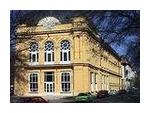 A
gallery that is mostly dedicated to the work of Janos Kass, a Hungarian
artist and freeman of Szeged. You can see many of his famous graphics,
illustrations and stamp designs including illustrations inspired by the
Bartok opera, Bluebeard`s Castle. Apart from the
collection
of his work there are other exhibitions of young artists.
A
gallery that is mostly dedicated to the work of Janos Kass, a Hungarian
artist and freeman of Szeged. You can see many of his famous graphics,
illustrations and stamp designs including illustrations inspired by the
Bartok opera, Bluebeard`s Castle. Apart from the
collection
of his work there are other exhibitions of young artists.
Curches in Szeged
There are over thirty churches in Szeged which belong to different religions. They are in very good conditions owing to the community and more and more people go to religious services to these places. I introduce some of the most important churches, first of all Dom, or the Votive church which is the symbol of Szeged. Unfortunately I cannot show you all but when you visit Szeged you can find many more.
The Votive Church of Szeged
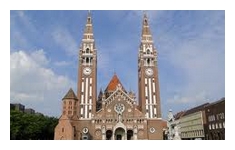 The
emblem of Szeged and one of its most distinctive building is the Votive
Church of Our Lady of Hungary. The construction was started in 1913 but
it was consecrated only in 1930 due to the outbrake of the First World
War. The Votive Curch is situated in Dom square which is
exactly the same
size as Saint Mark square in Venice. It is the fourth largest building
in Hungary, the dome is 54 metres high outside and 33 metres above the
inside floor. It has the third largest organ in Europe with 9,040
pipes. The two towers are 91 metres high.
The
emblem of Szeged and one of its most distinctive building is the Votive
Church of Our Lady of Hungary. The construction was started in 1913 but
it was consecrated only in 1930 due to the outbrake of the First World
War. The Votive Curch is situated in Dom square which is
exactly the same
size as Saint Mark square in Venice. It is the fourth largest building
in Hungary, the dome is 54 metres high outside and 33 metres above the
inside floor. It has the third largest organ in Europe with 9,040
pipes. The two towers are 91 metres high.
Above the main doorway
there is a 3 metres high statue of the Madonna. She is the patron of
this votive church and also the protector of Hungary since Stephen
I. You can see a lot of magnificent artwork throughout the
church. One of the most unusual is the Madonna in a fur
coat made
in mosaic just over the baldachin of the big altar.
Mass is held at 6:30 am., 7:30 am. and 6 pm. every day.
Synagogue
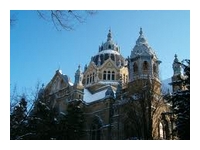 Another
fine example of church building int he 20th century in Szeged is the
Synagogue. This building is the second largest Jewish house of worship.
It was built in 1907 by Lipot Baumhorn, a famous Jewish architect. It
is 48 metres long, 35 metres wide and 48,5 metres high at its highest
part, at the dome and you can find many different architectural styles
on this moorish-art nouveau building. For example there are Gothic
elements above the organ but the columns holding the galleries are
Roman. Still, the mixing of styles remains concordant as the
ivory-blue-gold colour scheme creates a unity. The interior of the
Synagogue and all the stained glass windows are the work of the world
famous Hungarian artist, Miksa Roth.
Another
fine example of church building int he 20th century in Szeged is the
Synagogue. This building is the second largest Jewish house of worship.
It was built in 1907 by Lipot Baumhorn, a famous Jewish architect. It
is 48 metres long, 35 metres wide and 48,5 metres high at its highest
part, at the dome and you can find many different architectural styles
on this moorish-art nouveau building. For example there are Gothic
elements above the organ but the columns holding the galleries are
Roman. Still, the mixing of styles remains concordant as the
ivory-blue-gold colour scheme creates a unity. The interior of the
Synagogue and all the stained glass windows are the work of the world
famous Hungarian artist, Miksa Roth.
The most beautiful part of
the building is the dome. It is monumental and the decoration is
breathtaking. It symbolizes the world and every element has a meaning.
Int he middle you can see the star of David. You can also be delighted
at the door of the Ark of Covenant which is made of sittimwood from the
banks of Nile or the marble table under the High Altar made of marble
from Jerusalem. It is worth taking a stroll in the park
surrounding the synagogue as you can find a number of carefully
selected plants and flowers.
Apart from its obvious religious
purpose the synagogue functions as a concert hall as well as the
acoustics is perfect and it has 1300 seats. There are organ and other
classical concerts during the year and there is a Jewish Festival in
autumn every year.
Lower City Franciscan Church and Monastery
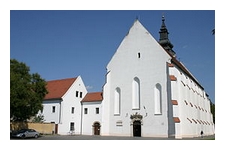 The
building of this church and monastery dates back to the early 15th
century making it the largest medieval monument to remain undamaged on
the Great Plain. On the outside the walls are whitewashed and inside
you can see a fine example of Gothic architecture with ribs and arches
covering the ceiling. The church has windows only on one side which is
also the characteristic of Gothic architecture. Unlike other churches
it still worked during the Turkish occupation and the priests made
efforts to remain the centre of Christianity. It is said this church
was the most beautiful church during Turkish occupation.
The
building of this church and monastery dates back to the early 15th
century making it the largest medieval monument to remain undamaged on
the Great Plain. On the outside the walls are whitewashed and inside
you can see a fine example of Gothic architecture with ribs and arches
covering the ceiling. The church has windows only on one side which is
also the characteristic of Gothic architecture. Unlike other churches
it still worked during the Turkish occupation and the priests made
efforts to remain the centre of Christianity. It is said this church
was the most beautiful church during Turkish occupation.
In the
main Altar you can see the picture of the Helping Madonna.
According to the legend a priests hid the picture from the Turkish in
a
nearby lake, Csoporke. It stayed there for about 100 years when a
Turkish soldier found it while his horse was drinking from the lake.
You can see this scene on the column left of the entrance. You can also
see the copy of the famous Black Madonna of Czestochowa.
Masses are held every day at 6 pm., at weekends at 7 am., 9 am. 3:30
pm. and 6 pm.
Parks and squares in Szeged
Szeged is a big city but there are green areas where you can relax and sit down on a bench or just let your children play int he green. Here you can find some of the most popular parks in Szeged.Dom Square in Szeged
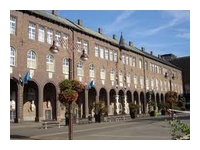 Dom
square is the most beautiful square in Szeged. It is dominated by the
Votive Church of Our Lady in Szeged but there are other equally
attractive elements in the square. The square was completed between
1929-32 On the western side you can see the Theological College of
Szeged, in the South-Western corner there is the Bishops Palace and
in the Southern and Eastern part Szeged University facilities and
research centres can be found. You can see an Arcade round
the
square where there is the National Panthenon. Originally it was founded
in 1930 but since then many more sculptures and reliefs were added. You
can see pieces of artwork depicting famous Hungarian scientists,
artists and historical personalities. In the Southern part of the
building surrounding the square there is a musical clock. It was made
in 1936 and you can see the 12 zodiac signs on it. There are figures
coming out of the clock and these figures were made
after real people, for example among the students we can see
famous Hungarian poets and artists of Szeged. In Dom square you can
also see the oldest building in Szeged which is the Domotor Tower in
front of the Votive Church, on the left. It dates back to 11th century
and it was restored in 1931.
Dom
square is the most beautiful square in Szeged. It is dominated by the
Votive Church of Our Lady in Szeged but there are other equally
attractive elements in the square. The square was completed between
1929-32 On the western side you can see the Theological College of
Szeged, in the South-Western corner there is the Bishops Palace and
in the Southern and Eastern part Szeged University facilities and
research centres can be found. You can see an Arcade round
the
square where there is the National Panthenon. Originally it was founded
in 1930 but since then many more sculptures and reliefs were added. You
can see pieces of artwork depicting famous Hungarian scientists,
artists and historical personalities. In the Southern part of the
building surrounding the square there is a musical clock. It was made
in 1936 and you can see the 12 zodiac signs on it. There are figures
coming out of the clock and these figures were made
after real people, for example among the students we can see
famous Hungarian poets and artists of Szeged. In Dom square you can
also see the oldest building in Szeged which is the Domotor Tower in
front of the Votive Church, on the left. It dates back to 11th century
and it was restored in 1931.
Szechenyi Square in Szeged
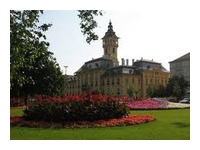 It
is one of the biggest square and park in Szeged city centre. Its whole
area is about 50 000 sq.m and it is the continuation of Karasz street,
the
main pedestrian street in Szeged. It is surrounded by official
buildings for example Szeged Town Hall, Main Post Office of Szeged,
banks, restaurants and Hotel Tisza. It used to be a market place but
today it is mainly used as a park and a place for different festivals
and fairs in Szeged. On the western part of the square you can find
Grunn-Orban house which was the place where the first printing press
worked in Szeged. Next to the Grunn-Orban house you can see a palace
called Rent
Palace built in 1872-73. It has always been rented by the
Town Hall that is
the reason for its name. Between the Town Hall and the palace you can
find the Bridge of Sighs of Szeged. It was built in 1883 when Franz
Joseph emperor visited Szeged. He stayed in the palace and through this
bridge he could easily reach the Town Hall without having to step out
in the street. The bridge is similar to the one in Venice. There are
some nice statues in the square for example Ferenc Deak,
Istvan
Szechenyi or Lajos Tisza, famous Hungarian politicians and also a
statue of King Stephen and his wife, Gizella
It
is one of the biggest square and park in Szeged city centre. Its whole
area is about 50 000 sq.m and it is the continuation of Karasz street,
the
main pedestrian street in Szeged. It is surrounded by official
buildings for example Szeged Town Hall, Main Post Office of Szeged,
banks, restaurants and Hotel Tisza. It used to be a market place but
today it is mainly used as a park and a place for different festivals
and fairs in Szeged. On the western part of the square you can find
Grunn-Orban house which was the place where the first printing press
worked in Szeged. Next to the Grunn-Orban house you can see a palace
called Rent
Palace built in 1872-73. It has always been rented by the
Town Hall that is
the reason for its name. Between the Town Hall and the palace you can
find the Bridge of Sighs of Szeged. It was built in 1883 when Franz
Joseph emperor visited Szeged. He stayed in the palace and through this
bridge he could easily reach the Town Hall without having to step out
in the street. The bridge is similar to the one in Venice. There are
some nice statues in the square for example Ferenc Deak,
Istvan
Szechenyi or Lajos Tisza, famous Hungarian politicians and also a
statue of King Stephen and his wife, Gizella
Dugonics Square in Szeged
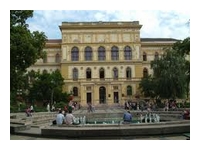 On the southern
end of Karasz street you can find Dugonics square. The main
attraction of the square is the musical fountain which was built for
the 100th anniversary of the flood in Szeged. You can mainly listen to
classical music during the day. It is a favourite meeting point among
the students of Szeged university. The dominant building of the square
is the building of Szeged University built in eclectic style in 1873.
Its name was Jozsef Attila University, Szeged, so you can find a Jozsef
Attilas statue nearby the university. It is often the place for
festivals and fairs.
On the southern
end of Karasz street you can find Dugonics square. The main
attraction of the square is the musical fountain which was built for
the 100th anniversary of the flood in Szeged. You can mainly listen to
classical music during the day. It is a favourite meeting point among
the students of Szeged university. The dominant building of the square
is the building of Szeged University built in eclectic style in 1873.
Its name was Jozsef Attila University, Szeged, so you can find a Jozsef
Attilas statue nearby the university. It is often the place for
festivals and fairs.
Stefania, Szeged
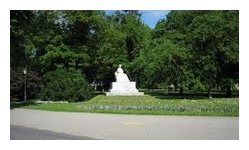 Stefania
is a promenade along the river bank in Szeged. It is a very relaxing
place in Szeged where you can take long walks and enjoy the view of the
River Tisza. You can find the remains of Szeged castle there. It was an
important castle, Szeged Peace treaty was signed here in 1444. You can
also see the statue of Sissy, who is still very popular in Hungary. Her
statue is made of marble from Carrara. From the promenade you can see
the Theatre of Szeged as well.
Stefania
is a promenade along the river bank in Szeged. It is a very relaxing
place in Szeged where you can take long walks and enjoy the view of the
River Tisza. You can find the remains of Szeged castle there. It was an
important castle, Szeged Peace treaty was signed here in 1444. You can
also see the statue of Sissy, who is still very popular in Hungary. Her
statue is made of marble from Carrara. From the promenade you can see
the Theatre of Szeged as well.
